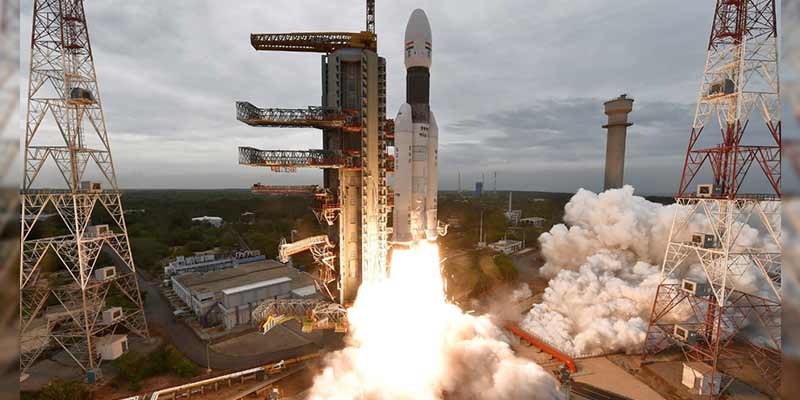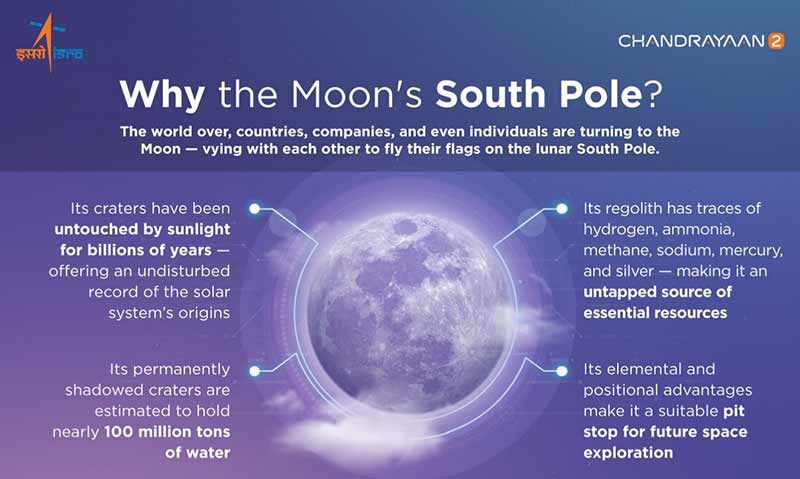- India
- Jul 24
First anniversary of Chandrayaan-2
India’s second lunar mission — Chandrayaan-2 — marked one year of completion of launch.
Chandrayaan-2, aimed at landing a rover on Lunar South Pole, was launched on July 22, 2019 on board the country’s most powerful geosynchronous launch vehicle, GSLV MkIII M1.
What is the status of the mission?
Indian Space Research Organisation (ISRO) said all its eight payloads are performing well.
The global mapping of the lunar surface and polar coverage are being carried out as per the mission plan. The public release of science data from Chandrayaan-2 for global use will begin in October.
Extensive data has been acquired from Chandrayaan-2 payloads and parameters are being derived for:
* Presence of water-ice in the polar regions.
* X-ray based and Infrared spectroscopic mineral information.
* Mid and high latitude presence of Argon-40, a condensable gas on the Moon which gets released internally by radio-active decay of 40 K.
The report on the major findings from Chandrayaan-2 science experiments was planned to be released at the Annual Lunar Planetary Science Conference in March 2020, but was cancelled due to the COVID-19 pandemic.
Chandrayaan-2 at a glance
The Chandrayaan-2 mission was India’s first attempt to land on the lunar surface.
Only three countries — the US, Russia and China — were able to perform a soft landing on the Moon and put a rover on it.
The mission was a highly complex mission, which represents a significant technological leap compared to the previous missions of ISRO.
It was designed to expand the lunar scientific knowledge through detailed study of topography, seismography, mineral identification and distribution, surface chemical composition, thermo-physical characteristics of top soil and composition of the tenuous lunar atmosphere, leading to a new understanding of the origin and evolution of the Moon.
It aimed at studying not just one area of the Moon but all the areas combining the exosphere, the surface as well as the sub-surface of the moon in a single mission.
Why was the South Pole targeted?
Moon provides the best linkage to Earth’s early history. It offers an undisturbed historical record of the inner Solar system environment. Though there are a few mature models, further explanations were needed to understand the origin of the Moon. Extensive mapping of lunar surface to study variations in lunar surface were essential to trace back the origin and evolution of the Moon. Evidence for water molecules discovered by Chandrayaan-1, required further studies on the extent of water molecule distribution on the surface, below the surface and in the tenuous lunar exosphere to address the origin of water on the Moon.
In the Lunar South pole, the surface area that remains in shadow is much larger than that at the North Pole. There could be a possibility of presence of water in permanently shadowed areas around it. In addition, the South Pole region has craters that are cold traps and contain a fossil record of the early Solar System.
What were the main stages of the mission?
GSLV Mk-III is a three-stage vehicle and India’s most powerful launcher. It is capable of launching a 4-ton class of satellites to the Geosynchronous Transfer Orbit (GTO).
The spacecraft had three modules — Orbiter, Lander (Vikram) and Rover (Pragyan).
The Orbiter’s mission was originally supposed to last a year. However, the Orbiter will function for seven years, revolving around the Moon and collecting data on the lunar surface and atmosphere.
After the injection of Chandrayaan-2, a series of maneuvers were carried out to raise its orbit and on August 14, 2019, following Trans Lunar Insertion (TLI) maneuver, the spacecraft escaped from orbiting the earth and followed a path that took it to the vicinity of the Moon.
On August 20, 2019, Chandrayaan-2 was successfully inserted into lunar orbit. While orbiting the moon in a 100 km lunar polar orbit, on September 2, 2019, Vikram Lander was separated from the Orbiter in preparation for landing.
On September 7, Chandrayaan-2’s Vikram lander lost its contact with ISRO as it was only 2.1 km away from its designated landing spot on the Moon’s South Pole region.
It was later found that Vikram made a hard landing on the lunar surface.
Plan for Chandrayaan-3
In March this year, the government confirmed that Chandrayaan-3 will be launched in the first half of 2021.
In a written reply in Lok Sabha, Union Minister Jitendra Singh said the revised configuration takes care of the robustness in design, capacity enhancement for mission flexibility and at the same time retained the heritage of Chandrayaan-2 to the extent possible.
Manorama Yearbook app is now available on Google Play Store and iOS App Store


